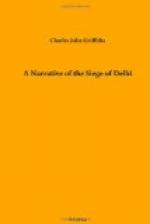The evidence was most clear as to the heinous offences of mutiny and rebellion with regard to all these men, and they were accordingly found guilty. Sentence was at once pronounced on fourteen of the sepoys, and the punishment was death.
Two men of low caste were to be hanged, while the remaining twelve, comprising Mohammedans and high-caste Hindoos, were to expiate their crime by that most awful and ghastly penalty, execution by being blown to pieces from the mouths of cannons.
This terrible punishment had been but seldom inflicted during British rule in India, the last instance occurring in 1825, when a native regiment mutinied and refused to cross the sea to take part in the first Burmese War.
Neither was it from the English that this special death penalty originated. It had been for hundreds of years the recognized punishment for mutiny and rebellion throughout Hindostan, and in numberless cases was carried out by the Mogul Emperors.
With us at this period it was found necessary to strike terror into the hearts of the rebels, to prove to them that we were resolved at all hazards to crush the revolt, and to give warning that to those who were taken fighting against us no mercy would be shown.
On religious grounds also the infliction of the death penalty by blowing away mutineers at the mouths of cannons was dreaded both by the Hindoos and Mohammedans.
The Hindoo, unless the corpse after death is burnt to ashes with all ceremony, or else consigned to the sacred stream of the Ganges, cannot partake of the glories of the future state, nor dwell in bliss everlasting with the gods of his mythology.
So with the Mohammedan, the Koran enjoins that all true believers must be buried with the body in the natural state, and only those are exempted who have lost limbs in fighting against the infidel. The joys of Paradise, where ever-young and beautiful houris minister to the wants and pleasures of the faithful, were therefore not for those who met a shameful death and were denied or unable to obtain burial in the orthodox manner.
Thus, it will be seen, the terrors of future shame and dishonour resulted to both Hindoo and Mohammedan by the death we were about to inflict on them; and it was for the awe inspired by the punishment that the military authorities at this time thought proper to carry it out in this unaccustomed manner.
June 13.—The morning of June 13 was fixed upon for the execution. A gallows was erected on the plain to the north side of the fort, facing the native bazaars, and at a distance of some 300 yards. On this two sepoys were to be hanged, and at the same time their comrades in mutiny were to be blown away from guns.
We paraded at daylight every man off duty, and, with the band playing, marched to the place of execution, and drew up in line near the gallows and opposite the native quarter.
Shortly after our arrival the European Light Field Battery, of six guns, appeared on the scene, forming up on our left flank, and about twenty yards in front of the Light Company.




